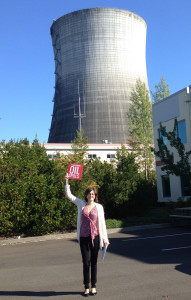People power dominated the first public hearing on the proposed oil holding facilities in Grays Harbor County. Earth Ministry staff and members attended this hearing to represent moral concerns about the poor stewardship of these dangerous projects. Outreach Coordinator, Jessica Zimmerle, is quoted below.
By Kyle Mittan
The Daily World
October 2, 2015
Members of the public voiced concerns for Grays Harbor’s fish, birds, estuaries and the safety of its citizens Thursday afternoon at the first public hearing following the release of the draft environmental impact statements on two proposed crude oil facilities at the Port of Grays Harbor.
The hearing was the first of two during a public comment period that runs until the end of the month.
The hearing’s comment session from 1:30 to 4:30 p.m. on Thursday at Satsop Business Park in Elma was the first of two for the day, with another from 6 to 9.
All of the comments — which included about 50 spoken before officials at the hearing on Thursday afternoon —will be read, considered and possibly used to finalize the statements on the two terminals’ potential impacts on the environment.
The hearing attracted commenters from as far away as Portland, Seattle and Spokane, who spoke alongside Harborites — the vast majority of whom opposed the two projects.
“It’s good to have this large of a turnout,” said Tammy Domike, field coordinator for Citizens for a Clean Harbor, which opposes the projects on environmental and safety grounds.
About 50 people were at the event at its peak for the first session, filling out much of the available seating but leaving plenty empty. Speakers directed their comments to Hoquiam City Administrator Brian Shay and Paula Ehlers, who oversees shorelands and environmental assistance for the Department of Ecology’s southwest region.
Though many came to testify on behalf of themselves and their neighbors, others came to give a voice for those who couldn’t speak. Jen Syrowitz, a chapter conservation manager with Audubon Washington from Tacoma, urged officials to look out for species like the red knot, a shorebird that uses Grays Harbor almost exclusively during their migration, she said.
“My bottom line to you today is that one spill or explosion could wipe out an entire species, or as you’ve heard, an entire human community,” Syrowitz said during her comment period.

Jessica Zimmerle came from Seattle to represent Earth Ministry, a faith-based environmental organization where she works as outreach coordinator. During her testimony, Zimmerle talked about her past experience cleaning shorebirds victimized by past oil spills, and told officials the community has “a moral obligation to do better.”
“I live and work in an oil train blast zone in Seattle and that’s not something that helps me sleep soundly at night,” she said after her testimony. “I don’t want that to increase for other members of our community elsewhere, especially out here.”
Others were keen to point out the irony of the hearing’s venue — an unused nuclear power plant that sits on property the Port now owns and maintains.
“Satsop doesn’t get enough credit — it’s the safest nuclear plant in the world,” said Robin Moore, from Hoquiam, garnering laughter from the crowd. “You people have the power to make these oil tanks the safest oil tanks in the world. Deny the permits.”
Others saw the looming nuclear towers as reasons to move forward with the projects. Ray Brown, a Westport resident, was one of the very few who came to the mic to voice support.
“I think it’s ironic that we stand here in the rubble of an energy project that was defeated by these energy-haters many years ago,” Brown said, adding that the community could benefit from the leadership Westway Terminals and Renewable Energy Group could bring to the community, along with the jobs. “We’ve seen the disaster that resulted from that — and the loss of revenue, the loss of jobs, prestige.”
Though some speakers had qualms with the event’s setup — particularly the two-minute restriction to comment on documents totaling more than 3,600 pages — officials felt the process was effective.
“The comments that really focus in on where people see weaknesses in the draft are where it’s the most helpful,” Shay said. “We realize that 99.9 percent of the people here are not going to be for the projects, but in putting together the draft and, ultimately, the final EIS, we want to make sure the EISs can be done to cover all the areas of concern. So hearing the areas that citizens think need further study is the most help.”
Steve Williams, terminal manager for Westway Terminals, also said the process had been helpful in identifying the public’s concerns.
“We want to be a good partner within this community,” he said. “We welcome all comments because it does allow us to examine all aspects and make sure that we’ve covered everything.”
Just two months after Renewable Energy Group purchased Imperium Renewables’ Grays Harbor property, company leaders said they were attending the hearing to get informed.
“We’re here today to listen and to learn,” Corporate Affairs Director Scott Hedderich said in his testimony. “We will be sure to factor economic impacts, regulatory compliance and community opinions into any decision.”
The second hearing for the statements is scheduled for 1 to 9 p.m. on Thursday at the D&R Theatre at 205 S. I St. in Aberdeen. The turnout for that hearing is expected to be in the hundreds, with a rally planned just before the event.
Please click here to view the original article.
